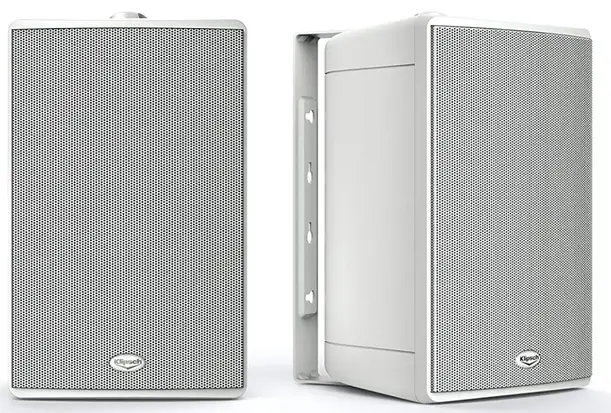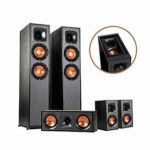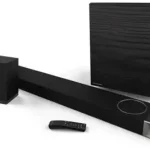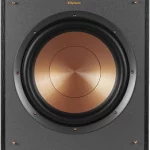
Klipsch KHO-7 Outdoor Loudspeaker

Specifications
- SPEAKER TYPE: Outdoor
- BRAND: Klipsch
- MODEL NAME: KHO-7
- RECOMMENDED USES FOR PRODUCT: Indoor, Outdoor
- SPECIAL FEATURE: Built-in Elevation
- PRODUCT DIMENSIONS: 12.3 x 6.8 x 8.3 inches
- ITEM WEIGHT: 6 pounds
Introduction
The Klipsch KHO-7 indoor/outdoor loudspeaker, with its UV-resistant ABS shell and aluminum grille and fittings, is built to last for years in the roughest of environments. The paintable KHO-7 is available in a white finish and comes with a rustproof C-style mounting bracket and port plug, making installation quick and easy. Its 8-ohm impedance also makes it compatible with any amplifier. The Klipsch KHO-7 speaker features a 5.25″ poly cone woofer and a 1″ silk dome tweeter with a proprietary Klipsch Tractrix(R) Horn for dazzling, lifelike sound. This sophisticated horn design boosts efficiency substantially, allowing the loudspeaker to provide higher output while using less energy. When it comes to all-weather loudspeakers, durability is the most valued—and desired—feature. Klipsch’s KHO-7 is an indoor/outdoor loudspeaker that sounds like rain.
PRODUCT OVERVIEW

PLACEMENT
There are a number of applications where the Klipsch KHO-7 is the perfect solution for outdoor sound
- patios, decks, swimming pools, porches or any other place where exposure to the elements makes conventional loudspeaker usage unacceptable.
Many of the placement recommendations for indoor use also apply in outdoor applications. The most common difference is the desire or needs to mount the speakers above ear level on a wall or under an overhang. To achieve the best performance from your KHO-7, place both speakers on the same wall facing the listening area and space them 6-15 feet apart. For a higher-quality stereo image, angle down, or toe in the speakers toward the primary listening area. This is especially important in installations that place the speaker well above ear level. Some additional bass will result if you place the speakers in a corner or near a wall: This provides greater bass coupling due to the additional reflected energy from the walls.
WALL MOUNTING
Included with your KHO-7 speakers are “C”-style mounting brackets that provide tremendous placement flexibility. Constructed of weather-resistant powder-coated aluminum to ensure years of reliable service, these brackets are the recommended method of mounting and supporting your speakers. The bracket is attached to the speaker with the supplied low-profile knobs, which thread into the top and bottom of the cabinet. This allows the speaker to be angled to the left or right when mounted vertically, or up and down when mounted horizontally.
After determining the desired location and orientation of your KHO-7, remove the bracket from the loudspeaker and use it as a template to mark the location of the mounting holes. Check the alignment of the holes with a torpedo level before drilling the properly sized pilot hole at the marked locations. Use #10-12, 2.5-3” long pan head screws to attach the bracket to a wall stud. Affix the speaker to the bracket with the supplied knobs. Be sure to leave enough clearance between the end of the bracket and any adjacent wall or ceiling for the installation of the knobs.
If a wall stud if not available, use the appropriate type of drywall or masonry anchor to support the weight of the speaker, allowing for a generous safety margin.
Please consult your dealer, custom installer, or a building contractor in these situations.
USE OF THE PORT PLUG
A vinyl port plug is included for installations that may expose the KHO-7 to extremely wet weather conditions. The internal components are water-resistant; however, it is best to avoid having standing water inside the cabinet whenever possible. To insert the plug, gently pry off the metal grille taking care not to bend it or chip the paint. Insert the closed end of the plug into the port until the fit is snug. DO NOT use excessive force! Use of the port plug will result in a slight loss in the bass frequencies but will make your speakers more weather-resistant and ensure a long and trouble-free life.
HOW TO CONNECT
Switch your electronics OFF when making all connections! Connect your KHO-7 speakers to the “Front” or “Main” left and right channels of your system’s power amplifier. Be sure to observe proper polarity (+ to + and – to -) and avoid having excess bare wire at the connectors, which could short together causing possible amplifier damage. Refer to “About Speaker Wire Connections”
ABOUT SPEAKER WIRE CONNECTIONS
When making any type of speaker wire connection, be sure to observe proper polarity. Most speaker wire is color-coded or has some distinguishing feature differentiating the two conductors. Speaker wire connectors on most loudspeakers and amplifiers are also color-coded. Typically, Red is positive (+) and Black is negative (-), or ground. It does not matter which wire conductor is connected to the positive or negative connections of your equipment as long as you are consistent. Be sure that the connections from the amp to the speaker on all of the various channels of your system are connected in a like manner. If this is not done, the number of basses will be reduced and the stereo image will be compromised. Be careful not to have excess bare wire or lose strands of wire that could short from positive to negative as this could damage the speaker and amplifier. A high-quality speaker cable can make an audible improvement in the sound of your speakers. Your Klipsch dealer can assist you in selecting the proper cable to ensure optimal performance from your loudspeakers.
PAINTING
The grille and cabinet of your KHO-7 may be painted to match the exterior decor of your house or to blend in with the surrounding environment. For best results, properly prepare the surface before painting. Lightly sand all surfaces to be painted (cabinet and grille) with 300-400 grit sandpaper. Wash these surfaces with a moistened cloth dipped in a mild detergent to remove any fingerprints or grease. Allow drying before painting.
Care must be taken to mask off the front of the speaker to protect the tweeter, woofer, and front panel from over-spray. This will maintain the existing uniform dark color behind the grille and protect the woofer and tweeter from being damaged by the paint. Affix masking tape to the inboard wall of the grille groove and attach plastic or newspaper to the tape to cover the entire front panel of the speaker. Also, before painting, mask the speaker wire binding posts on the rear of the cabinet to preserve the color-coding and conductivity. Make sure that the black and red knobs are screwed down to cover the threaded metal shafts and wrap the knobs securely in masking tape.
Remove the grille before painting. For best results, use several light coats of paint instead of one heavy coat. This will help prevent the perforations in the grille from becoming clogged in paint.
Frequently Asked Questions
- Is it possible to get Klipsch outdoor speakers wet?
Klipsch outdoor speakers are built to withstand everything Mother Nature throws at them and keep on going. After years of exposure to the sun, rain, and snow, these speakers will still be running strong. - Klipsch Kho 7 speakers have how many watts?
The speakers have a frequency response of 65Hz to 20KHz and a strong bottom, which is required to generate superb sound. The Klipsch kho 7 has a maximum output of 300 watts and a nominal power of 75 watts. - Is it necessary to cover outdoor speakers?
Because many outdoor speakers are weather-resistant rather than weatherproof, they will require protection. Is the ground (or the deck) close to your eaves? Underneath the speakers, mount them to shield them from the weather. Just make sure they’re not more than 10 feet above the listening area. - What’s the best way to hook up my Klipsch speakers to my receiver?
Connect the subwoofer to the AV receiver with a subwoofer cable (RCA cable) that runs from the receiver’s subwoofer output to the subwoofer’s line input. Klipsch subwoofers can be linked using the LFE channel, the white RCA connection, or both the white and red RCA connections in a stereo pair. - Is an amplifier required for outdoor speakers?
Most outdoor speakers are passive devices, which means they lack built-in amplification and must be powered separately. - How do you keep outside speakers dry while it rains?
To keep outdoor speakers safe, keep them out of the sun and away from water.
When it’s too wet to bring them inside during terrible weather, cover them.
Check the mount hardware on a frequent basis.
Check the wiring on a regular basis.
Ensure that the speakers are clean on a regular basis. - What is the ideal height for outdoor speakers?
Mounting speakers at a distance of 10 feet from the ground is ideal for striking a balance. This will allow sound to travel a reasonable distance without compromising audio quality. When it comes to using many outdoor speakers, a multi-channel amplifier is a must-have item. - What is the best location for Klipsch speakers?
The left and right front speakers should be at least six feet apart and at an identical distance from the screen, forming an equilateral triangle with the primary viewing/listening position. Some toe-in might be beneficial to further enhance the experience. - What’s the best way to make my outdoor speakers wireless?
Regular speakers become wireless with wireless speaker kits, which transfer the audio signal via an RF (radio-frequency) transmission. To give a high-quality wireless signal to your surround speakers, simply add a wireless speaker kit. A transmitting and receiving equipment is included in these kits. - Is a subwoofer required for outdoor speakers?
It’s difficult to duplicate bass notes outside because there are no barriers to bounce low sound frequencies off of. If the lack of bass notes bothers you, an outside subwoofer should be added to your system.



